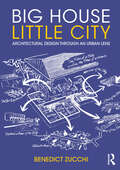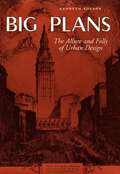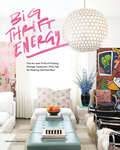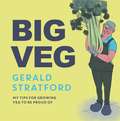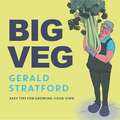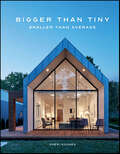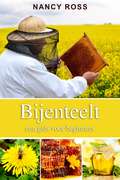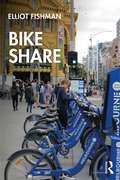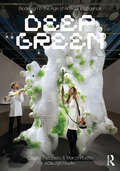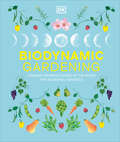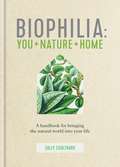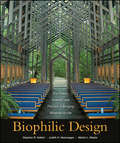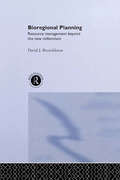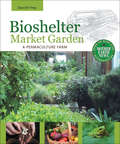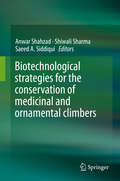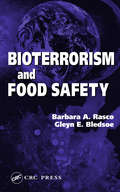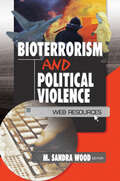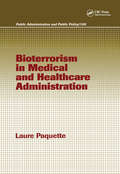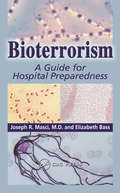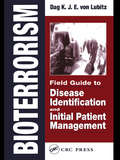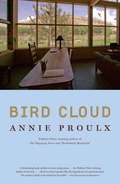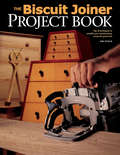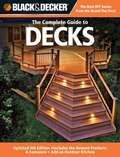- Table View
- List View
Big House Little City: Architectural Design Through an Urban Lens
by Benedict ZucchiCombining architectural and urban thinking in an unusual and engaging way, this book presents an integrated approach to architectural theory and design. Leon Battista Alberti’s assertion in his famous Renaissance treatise that ‘the city is like a big house, and the house is in turn like a little city’ forms the springboard for a series of reflections on architecture’s relationship with urbanism and how their once intimate symbiosis, unravelled by International Style Modernism, can be recovered. Explicit references to Alberti’s house-city phrase have been made by figures as diverse as the architects Louis Kahn, Aldo Van Eyck, Denys Lasdun and Niels Torp and novelist Italo Calvino. But, as the book shows, thinking of buildings as little cities provides a new lens through which to reappraise the contributions of many other architects, including Le Corbusier, Frank Lloyd Wright, Alvar Aalto, Eliel Saarinen, Bernard Rudofsky, Hans Scharoun, Leon Krier, Fumihiko Maki, Charles Correa and Team 10. In doing so, the author identifies common themes that form an unexpected bridgehead between the urban and architectural approaches of Antiquity, the Middle Ages, Renaissance and 20th century. The book explores buildings from across the globe, including lesser-known projects, such as Wright’s unbuilt house in Italy or Saarinen’s master plan for Cranbrook Academy, as well as more recent projects by Niels Torp, Behnisch Architekten, Sou Fujimoto, Peter Barber and WOHA. It concludes with practical case studies of residential, health, education and workplace projects from different countries, fulsomely illustrated with many drawings and photographs. These show how architectural design viewed through an urban lens provides a conceptual framework for breaking down the scale of large buildings and integrating them with their context. And crucially, these also show a very accessible way of explaining evolving designs to the intended users and eliciting their participation in the design process. The book offers a compelling approach to the design of projects at all scales, within an ecological perspective: the sense that big and small, cities and buildings must be approached holistically if we are to reverse the degradation and depletion of our habitat, both natural and man-made.
Big Plans: The Allure and Folly of Urban Design (Center Books on Contemporary Landscape Design)
by Kenneth KolsonBig Plans: The Allure and Folly of Urban Design springs from the idea that human aspirations for the city tend to overstate the role of rationality in public life. Inspired by the architectural and urban criticism of such writers as Lewis Mumford, Jane Jacobs, and John Brinckerhoff Jackson, Kolson adopts a user's perspective on issues of urban design, an approach that highlights both the futility of social engineering and the resilience of the human spirit.
Big Thrift Energy: The Art and Thrill of Finding Vintage Treasures-Plus Tips for Making Old Feel New
by Virginia ChamleeLearn to find affordable vintage home decor and how to style it in a modern home.From a Goyard trunk worth upwards of $10,000 (scored for $90) to a floor-length vintage Christian Dior cape (a $10 Goodwill find), Virginia knows how to find deals.Danielle from Apartment Therapy says "Virginia has total sage sister vibes, helping you score pieces for a song with tips that are so good, I kind of can't believe she's letting us in on these trade secrets.&”Picked as a &“Best New Book&” by People Magazine, Big Thrift Energy will teach you everything you need to know about shopping for affordable vintage home decor and styling it in a modern home. Antiquing can be intimidating: how do you know if a piece is worth salvaging? How do you navigate the piles of merchandise at a thrift store or estate sale? Part resource, part inspiration, Big Thrift Energy is a comprehensive guide that offers tips for thrifting that you never knew you needed: How to shop for the good stuff, how to upcycle and style vintage treasures in your home, and even advice for flipping your most-coveted items to turn a profit. Big Thrift Energy will teach you:• Where to shop for antique and vintage treasures you'll love• The best things to buy used, and which items to pass on• How to upcycle something old into something "you" and make it fit beautifully in your home• How to tell when something is valuable, and tips for reselling it to make a profitAuthor Virginia Chamlee has spent more than a decade collecting and selling vintage wares. Her home has been featured on Apartment Therapy and Design*Sponge and her original artwork is available via Chairish, Anthropologie, and Artfully Walls.
Big Veg: Learn how to grow-your-own with 'The Vegetable King'
by Gerald StratfordLearn how to grow big veg with Gerald Stratford, the gardening grandad loved by over a quarter of a million fans on Twitter. "I am very grateful for all the interest my wonderful friends and followers have taken in my gardening. Now, I hope this book gives you the motivation you need to get out in the garden. Cheers!" - GERALDGerald's book is packed with decades of gardening know-how and fully illustrated with photos from his Cotswolds garden. It includes a helpful month-by-month guide to sowing, planting and harvesting veg, as well as tips on how to grow Gerald's speciality: really big veg. Full of encouragement and Gerald's infectious enthusiasm, Big Veg makes an ideal companion for anyone keen to grow-your-own.
Big Veg: Learn how to grow-your-own with 'The Vegetable King'
by Gerald StratfordLearn how to grow big veg with Gerald Stratford, the gardening grandad loved by over a quarter of a million fans on Twitter. "I am very grateful for all the interest my wonderful friends and followers have taken in my gardening. Now, I hope this book gives you the motivation you need to get out in the garden. Cheers!"- GERALDGerald's book is packed with decades of gardening know-how and fully illustrated with photos from his Cotswolds garden. It includes a helpful month-by-month guide to sowing, planting and harvesting veg, as well as tips on how to grow Gerald's speciality: really big veg. Full of encouragement and Gerald's infectious enthusiasm, Big Veg makes an ideal companion for anyone keen to grow-your-own.
Big Veg: Learn how to grow-your-own with 'The Vegetable King'
by Gerald StratfordLearn how to grow big veg with Gerald Stratford, the gardening grandad loved by over a quarter of a million fans on Twitter. "I am very grateful for all the interest my wonderful friends and followers have taken in my gardening. Now, I hope this book gives you the motivation you need to get out in the garden. Cheers!" - GERALDGerald's book is packed with decades of gardening know-how from his Cotswolds garden. It includes a helpful month-by-month guide to sowing, planting and harvesting veg, as well as tips on how to grow Gerald's speciality: really big veg. Full of encouragement and Gerald's infectious enthusiasm, Big Veg makes an ideal companion for anyone keen to grow-your-own.(P)2021 Headline Publishing Group Limited
Bigger Than Tiny, Smaller Than Average
by Sheri KoonesSmaller, more environmentally-friendly houses seem to be the wave of the future. As people chose to move out of cities, finances and life style will limit the size of the houses these new home owners will choose. This book includes lots of examples of small house options around the country, including ADUs (accessory dwelling units). Whether you’re building a small house, renovating an older home, or purchasing something new, this book will provide inspiration. It compiles lots of previously difficult-to-find information in one place. The sidebars describe home systems and new materials helpful to any homeowner concerned about the environment and hoping to save money on energy and maintenance.
Bijenteelt: een gids voor beginners
by Nancy RossOf je nu je eigen honing wilt maken, de productie van je groentetuin wilt stimuleren of voor het pure plezier van bijenteelt, dit boek kan je helpen. Hier is een voorbeeld van wat u zult leren ... Hoeveel bijenkorven moet ik hebben? Waar vind ik mijn bijen? De juiste benodigdheden kiezen Je bijenkorf opzetten Hoe de honing te verzamelen Veelvoorkomende problemen waarmee u te maken kunt krijgen met bijenteelt Tips om te slagen in de bijenteelt Veel, veel meer!
Bike Share
by Elliot FishmanThere are now over 2,000 cities with a bike share program. Bike Share examines all the major developments in the 50-year history of bike share. The book provides a detailed focus on contemporary bike share programs, including many of the most prominent systems, such as those in Paris, London, and New York, as well as the rapidly emerging dockless bike share sector. This book also addresses how rapid technological innovation, particularly in terms of mobile internet devices and electric assist bicycles may change the face of not just cycling, but urban mobility more generally. By the end of 2018 it was estimated that there are more than 20 million bicycles in the global bike share fleet, with most of these dockless, coming online only in the last three years. Consequently, research examining bike share has not kept pace with the rapid deployment of this new form of urban mobility. Bike Share addresses a number of key themes such as: The urban age, contextualising bike share within a wider urbanism movement and how it sits within the growing sharing economy. The impact of bike share, looking at systems in China, Europe, North America and Australia to see how these programs have changed travel patterns and consequent impact on car use, emissions, congestion, public health and safety. The bike share business model, including how ride sourcing services like Uber and Lyft are beginning to integrate their business with bike share service providers. Public reaction to bike share. Bike share gone wrong, looking at systems that have failed to achieve their ridership estimates. And the future of bike share including public transport smart card integration, mobile payments, and electric assist bicycles. The book provides scholars, city planners, transportation practitioners and students with a resource that captures the most pertinent scientific findings and practical lessons that have been from bike share programs around the world.
Biodesign in the Age of Artificial Intelligence: Deep Green
by Marco Poletto Claudia PasqueroBiodesign in the Age of Artificial Intelligence: Deep Green investigates the potential of nature-based technology for shaping the evolution of contemporary architecture and design. It takes on the now pervasive topic of design intelligence, extending its definition to encompass both biological and digital realms. As in their first title, Systemic Architecture: Operating Manual for the Self-Organizing City, the authors engage the topic through the specific lens of their innovative design practice, ecoLogicStudio, and their research at the University of Innsbruck and at the Bartlett, UCL. Part One of the book, entitled PhotoSynthetica™, illustrates design solutions that engage the urban microbiome and seek to achieve an immediate impact, while Part Two, entitled Deep Green, includes synthetic landscapes and operates within a much larger spatio-temporal frame, going beyond human perception and life span to envision design as a geographical and geological force. In the age of catastrophic climate change, such perceptual expansion helps to clarify that change cannot simply be stopped or rolled back. We must instead establish more positive dynamics of change within the living world. To this end, this book proposes to engage with design and architecture as an extended cognitive interface, a sentient being that is co-evolutionary and symbiotic with the living planet, contributing to its beauty and to our continued enjoyment of it.
Biodynamic Gardening: Organic Growing Guided by the Moon for Bountiful Harvests
by DKWhether you're just getting started in biodynamic gardening, or you're an experienced biodynamic farmer wanting to learn more, Biodynamic Gardening is the right resource for learning more about the biodynamic method of organic gardening. This clear, practical guide gives you tried-and-true advice on biodynamic gardening and tips on this ultra-green, organic gardening method. Full-color photographs and easy-to-understand charts and graphs are helpful tools in organizing information in a way anyone can understand and use in biodynamic gardening. Biodynamic gardening makes use of natural cycles and mindful planting to take organic gardening to the next level, and Biodynamic Gardening covers everything. Topics include soil preparations, lunar charts, composting, cycles of rest, rich and healthy soil, organically controlling pests, ripening plants, and more. Grow delicious vegetables and healthy food, or grow beautiful blooms and flowers with the information you'll find in Biodynamic Gardening.
Biophilia: You + Nature + Home
by Sally CoulthardIn this beautifully illustrated guide, best-selling author Sally Coulthard demonstrates how to transform your living and working spaces into places that put you in touch with nature.Eight inspiring chapters cover key elements for the 'biophilic home', including materials, views, colour and natural light. Each section explores the links between home, health and happiness, drawing on environmental research and neuroscience while making practical suggestions for bringing the natural world into your home.Bring nature indoors with flowers and plants, rediscover the innate pleasure of real fires and fresh air, and learn how to improve your mood and sleep patterns with dynamic light. Create a space filled with natural elements, patterns, nature's colours, fabrics and textures that lift your mood; find out why natural sounds and water are soothing; and learn how to make small changes that will inspire, invigorate and enrich your relationship with the natural world.'As best-selling author and designer, Sally Coulthard, reveals in this guide, creating a 'biophilic home' can have a huge impact on your wellbeing; improving your mood and encouraging healthier sleep patterns...Be it plants, materials, colour or light, it's enlightening to see how small changes can make a big difference, while deepening your respect and correlation to the natural world.' FORBES Magazine'How to embrace the natural world by transforming your interior spaces with specific materials, colours, views and sounds.' Gardens Illustrated'Humans are mammals, programmed over millennia to respond to the natural world. We may be able to live and work in man-made environments most of the time. But according to a new movement of "biophilic" designers and enthusiasts, we are not thriving...writer Sally Coulthard likens it to the practice of keeping animals in captivity, in surroundings ill-suited to their needs. "We live in a world that is fundamentally mismatched to our evolutionary adaptation - we don't see, hear and feel the things that we are programmed to respond to," she writes.' Financial Times
Biophilia: You + Nature + Home
by Sally CoulthardIn this beautifully illustrated guide, best-selling author Sally Coulthard demonstrates how to transform your living and working spaces into places that put you in touch with nature.Eight inspiring chapters cover key elements for the 'biophilic home', including materials, views, colour and natural light. Each section explores the links between home, health and happiness, drawing on environmental research and neuroscience while making practical suggestions for bringing the natural world into your home.Bring nature indoors with flowers and plants, rediscover the innate pleasure of real fires and fresh air, and learn how to improve your mood and sleep patterns with dynamic light. Create a space filled with natural elements, patterns, nature's colours, fabrics and textures that lift your mood; find out why natural sounds and water are soothing; and learn how to make small changes that will inspire, invigorate and enrich your relationship with the natural world.'As best-selling author and designer, Sally Coulthard, reveals in this guide, creating a 'biophilic home' can have a huge impact on your wellbeing; improving your mood and encouraging healthier sleep patterns...Be it plants, materials, colour or light, it's enlightening to see how small changes can make a big difference, while deepening your respect and correlation to the natural world.' FORBES Magazine'How to embrace the natural world by transforming your interior spaces with specific materials, colours, views and sounds.' Gardens Illustrated'Humans are mammals, programmed over millennia to respond to the natural world. We may be able to live and work in man-made environments most of the time. But according to a new movement of "biophilic" designers and enthusiasts, we are not thriving...writer Sally Coulthard likens it to the practice of keeping animals in captivity, in surroundings ill-suited to their needs. "We live in a world that is fundamentally mismatched to our evolutionary adaptation - we don't see, hear and feel the things that we are programmed to respond to," she writes.' Financial Times'In this beautifully illustrated hardback, Coulthard explores the many benefits of biophilic design, drawing on environmental and neuroscientific research to uncover the links between home, health and happiness. A fascinating and uplifting read that looks at the science behind feel good furnishings.'The Independent'Never before has the need been greater for being more connected with the natural world, as more and more of us spend longer periods in our own homes. Divided into eight chapters covering key elements for the 'biophilic home', including materials, views, colour and natural light, the book explores the links between home, health and happiness. Drawing on environmental research and neuroscience, Sally makes practical suggestions for bringing the natural world into our homes, positively impacting cognitive function, psychological health and general well-being.' The Lifestyle Editor'...bestselling author Sally Coulthard picks out...the easiest ways we can bring nature indoors' Town and Country House magazine
Biophilic Design
by Stephen R. Kellert Martin Mador Judith Heerwagen"When nature inspires our architecture-not just how it looks but how buildings and communities actually function-we will have made great strides as a society. Biophilic Design provides us with tremendous insight into the 'why,' then builds us a road map for what is sure to be the next great design journey of our times."-Rick Fedrizzi, President, CEO and Founding Chairman, U.S. Green Building Council"Having seen firsthand in my company the power of biomimicry to stimulate a wellspring of profitable innovation, I can say unequivocably that biophilic design is the real deal. Kellert, Heerwagen, and Mador have compiled the wisdom of world-renowned experts to produce this exquisite book; it is must reading for scientists, philosophers, engineers, architects and designers, and-most especially-businesspeople. Anyone looking for the key to a new type of prosperity that respects the earth should start here."-Ray C. Anderson, founder and Chair, Interface, Inc.The groundbreaking guide to the emerging practice of biophilic designThis book offers a paradigm shift in how we design and build our buildings and our communities, one that recognizes that the positive experience of natural systems and processes in our buildings and constructed landscapes is critical to human health, performance, and well-being. Biophilic design is about humanity's place in nature and the natural world's place in human society, where mutuality, respect, and enriching relationships can and should exist at all levels and should emerge as the norm rather than the exception.Written for architects, landscape architects, planners,developers, environmental designers, as well as building owners, Biophilic Design: The Theory, Science, and Practice of Bringing Buildings to Life is a guide to the theory, science, and practice of biophilic design. Twenty-three original and timely essays by world-renowned scientists, designers, and practitioners, including Edward O. Wilson, Howard Frumkin, David Orr, Grant Hildebrand, Stephen Kieran, Tim Beatley, Jonathan Rose, Janine Benyus, Roger Ulrich, Bert Gregory, Robert Berkebile, William Browning, and Vivian Loftness, among others, address:*The basic concepts of biophilia, its expression in the built environment, and how biophilic design connects to human biology, evolution, and development.*The science and benefits of biophilic design on human health, childhood development, healthcare, and more.*The practice of biophilic design-how to implement biophilic design strategies to create buildings that connect people with nature and provide comfortable and productive places for people, in which they can live, work, and study.Biophilic design at any scale-from buildings to cities-begins with a few simple questions: How does the built environment affect the natural environment? How will nature affect human experience and aspiration? Most of all, how can we achieve sustained and reciprocal benefits between the two?This prescient, groundbreaking book provides the answers.
Bioregional Planning: Resource Management Beyond the New Millennium
by D J BrunckhorstPresenting a pragmatic mixture of science, landscape ecology, ecosystem management, sociology, policy development and methods for transforming social and institutional cultures. Bioregional Planning: Resource Management Beyond the New Millennium is a timely and practical guide for the analysis, planning and development of bioregional projects for a sustainable future. Significantly, this book presents the strategic actions necessary to plan for, manage and adapt to Ecologically Sustainable Development with a view beyond the new millennium and towards the next. Postgraduates, researchers and policy makers in natural resources management, land planning, sustainable agriculture, rural sciences, ecosystem management and conservation biology will find this book captures the essence of bioregional planning succinctly and makes a compelling argument for why it is a key mechanism in the development of effective governance institutions.
Bioshelter Market Garden: A Permaculture Farm (Mother Earth News Books for Wiser Living)
by Darrell Frey&“This well-illustrated case study . . . will help students of permaculture, of sustainability, of earth regeneration and of integrated eco-social design.&” —Prof. Declan Kennedy, Chairman, Advisory Board, gaiauniversity.org To ensure food security and restore the health of the planet, we need to move beyond industrial agriculture and return to the practice of small-scale, local farming. The Bioshelter Market Garden: A Permaculture Farm describes the creation of a sustainable food system through a detailed case study of the successful year-round organic market garden and permaculture design at Pennsylvania&’s Three Sisters Farm. At the heart of Three Sisters is its bioshelter—a solar greenhouse which integrates growing facilities, poultry housing, a potting room, storage, kitchen facilities, compost bins, a reference library and classroom area. The Bioshelter Market Garden examines how the bioshelter promotes greater biodiversity and is an energy efficient method of extending crop production through Pennsylvania&’s cold winter months. Both visionary and practical, this fully illustrated book contains a wealth of information on the application of permaculture principles. Some of the topics covered include: Design and management of an intensive market garden farmEnergy systems and bio-thermal resourcesEcological soil management and pest controlWetlands usageSolar greenhouse design and management Whatever your gardening experience and ambitions, this comprehensive manual is sure to inform and inspire.&“Darrell Frey&’s inspirational book gives you all you need to know to create an energy-saving, food-producing bioshelter . . . [It] covers everything you need to understand, build, or simply admire these important tools for sustainability.&” —Toby Hemenway, author of Gaia&’s Garden
Biotechnological strategies for the conservation of medicinal and ornamental climbers
by Anwar Shahzad Shiwali Sharma Saeed A. SiddiquiThe book provides an overview on adoption of biotechnological approaches for the conservation, micropropagation, synseed production of various medicinal and ornamental climbers. The work includes a brief chapter on evolution and diversification of climbers. Other chapters give insights on protocols for in vitro propagation and synseed production of selected threatened medicinal and ornamental climbers. Informative chapter on the production of bioactive compound and their enhancement through genetic transformation and elicitation have been incorporated to cover latest advancement in the field of plant biotechnology. This book also explores the use of molecular marker technique for the desired improvement/magnification of medicinal and aesthetic value of climbing plants.
Bioterrorism and Food Safety
by Barbara A. Rasco Gleyn E. BledsoeWritten by specialists in the fields of food bioterrorism and industry preparedness, Bioterrorism and Food Safety focuses on developing rational and implementable food security strategies and plans. It integrates food safety issues, technological developments in traceability, and legal analysis of current and pending regulations with good bu
Bioterrorism and Political Violence: Web Resources
by M. Sandra WoodThe Internet can be a bewildering maze of information, often from questionable sources. This book points the way to reliable information on bioterror! Since the September 11 attacks, there has been an unparalleled demand for information on bioterrorism. Bioterrorism and Political Violence: Web Resources is an ideal guide for people around the world who are turning to the Internet to find that information. This essential book provides you with comprehensive listings of many helpful websites, focusing on those run by government agencies, professional organizations, and educational institutions. Because of the dynamic nature of the Internet, Bioterrorism and Political Violence: Web Resource also gives you tips on searching for other useful sites. It examines sites covering the full spectrum of concerns, from anthrax and hate crimes to nuclear terrorism and disaster preparedness. Bilingual resources and ways to help children cope with our rapidly changing world are also highlighted throughout. It?s been said that ?information is the best defense,? and with this book you?ll be able to find the information you need. Bioterrorism and Political Violence: Web Resources will also show you how to find reliable information on related topics, including: post-traumatic stress disorder terms and issues related to terrorism in the Middle East sites that honor the victims of the September 11 attacks dealing with bereavement and grief the psychological impacts of terrorism
Bioterrorism in Medical and Healthcare Administration (Public Administration and Public Policy)
by Laure PaquetteBioterrorism in Medical and Healthcare Administration provides an efficient method to identify, manage, and control transformations in the provision of health services during elevated levels of bioterrorist threat - offering step-by-step procedures and templates to prepare and implement a coordinated response to high-alert situations. This reference proposes an efficient method to identify, manage, and control transformations in the provision of health services during elevated levels of bioterrorist threat - offering step-by-step procedures and templates to prepare and implement a coordinated response to high-alert situations.
Bioterrorism: A Guide for Hospital Preparedness
by Elizabeth Bass Joseph R. Masci M.D.In the battle against bioterrorism, one of the greatest challenges is finding the ideal balance between complacency and overreaction. The goal is to be so well prepared that we can prevent catastrophic outcomes in the event of a bioterrorist attack, while strengthening our ability to prevent and treat naturally-occurring infectious diseases.Bioterr
Bioterrorism: Field Guide to Disease Identification and Initial Patient Management
by Dag K.J.E. von LubitzThe outbreak of anthrax infections that followed September 11, 2001, showed all too clearly that while we can defend ourselves against bioterrorism, our defenses need improvement. What's most important is the ability to recognize the associated disease, and recognize them quickly. Yet, many in the medical world are unfamiliar with the characteristi
Bird Cloud: A Memoir of Place
by Annie ProulxPart autobiography, part natural history, Bird Cloud is the glorious story of Annie Proulx's piece of the Wyoming landscape and her home there."Bird Cloud" is the name Annie Proulx gave to 640 acres of Wyoming wetlands and prairie and four-hundred-foot cliffs plunging down to the North Platte River. On the day she first visited, a cloud in the shape of a bird hung in the evening sky. Proulx also saw pelicans, bald eagles, golden eagles, great blue herons, ravens, scores of bluebirds, harriers, kestrels, elk, deer and a dozen antelope. She fell in love with the land, then owned by the Nature Conservancy, and she knew what she wanted to build on it--a house in harmony with her work, her appetites and her character, a library surrounded by bedrooms and a kitchen. Bird Cloud is the story of designing and constructing that house--with its solar panels, Japanese soak tub, concrete floor, and elk horn handles on kitchen cabinets. It is also an enthralling natural history and archaeology of the region--inhabited for millennia by Ute, Arapaho, and Shoshone Indians--and a family history, going back to nineteenth-century Mississippi riverboat captains and Canadian settlers. Proulx, a writer with extraordinary powers of observation and compassion, here turns her lens on herself. We understand how she came to be living in a house surrounded by wilderness, with shelves for thousands of books and long worktables on which to heap manuscripts, research materials and maps, and how she came to be one of the great American writers of her time.
Biscuit Joiner Project Book: Tips & Techniques to Simplify Your Woodworking Using This Great Tool
by Jim StackBuilding furniture just got easier!If you're like most woodworkers, you're always looking for ways to save time. One of the best tools to deliver on that promise is the biscuit joiner. You may have heard that using biscuits, those little compressed wafers of wood, is a form of cheating. But it's not. Biscuits make strong joints and get the job done fast.Try any one of the attractive projects inside and you'll be amazed at how quick, easy and effective the joint-making process becomes. These 12 projects offer something for everyone, from a build-in-a-weekend cupboard to a white oak bookcase and an elegant tapered dresser.Best of all, many of the pieces have been adapted from traditional designs so you can make your favorite style of furniture with fewer hassles.Veteran cabinetmaker Jim Stack starts with the basics, and also includes dozens of additional tips on how to assure safe and accurate cuts, modify a design to fit your taste, correct mistakes and make the most of this versatile tool.Start this weekend! The biscuit joiner will reward you with great furniture - minus all the fuss.
Black & Decker: The Complete Guide to Decks (Updated 4th Edition)
by Creative Publishing InternationalA deck is an excellent tool for extending the living space of your home into the outdoors while offering a good return on your investment. This book begins with a gallery of beautiful decks to help get your creative juices flowing. This fully revised and updated edition of The Complete Guide to Decks offers everything you'll need to design and build your dream deck correctly and safely -- the first time.
